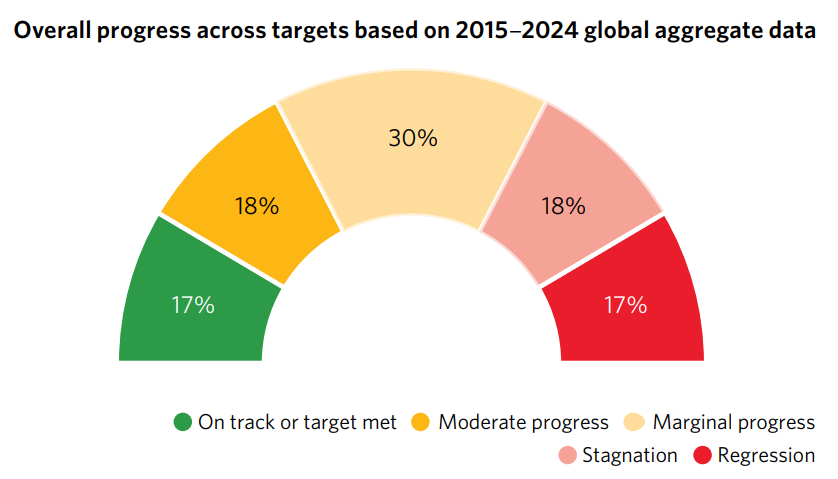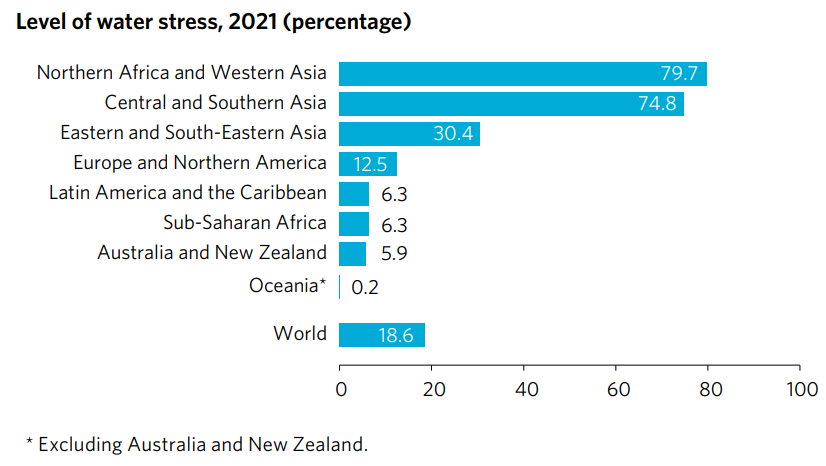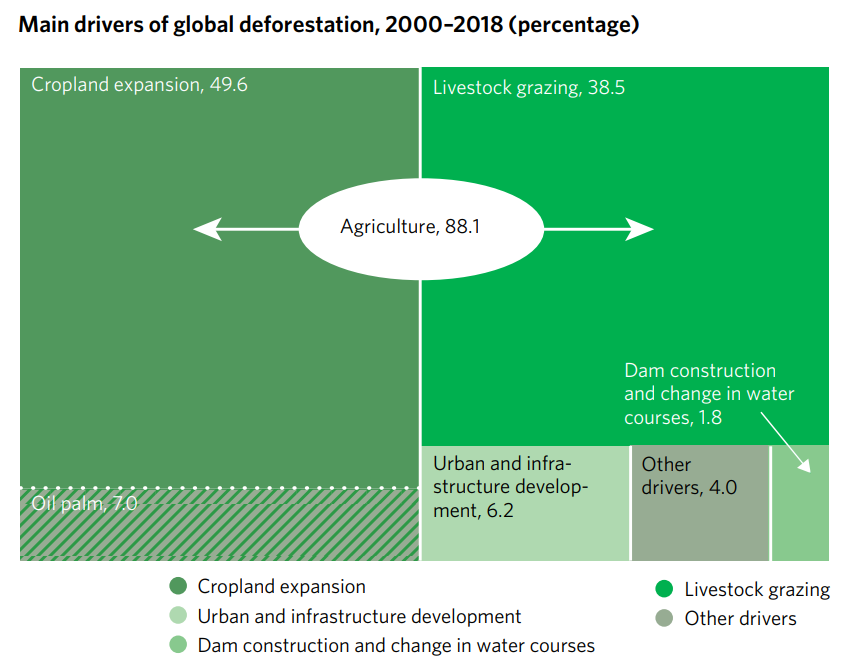Biodiversity & Environment
Sustainable Development Goals Report, 2024
- 04 Jul 2024
- 12 min read
For Prelims: UN Sustainable Development Solutions Network (SDSN), Sustainable Development Goals Report 2024, Sustainable Development Goals (SDGs), United Nations, 2030 Agenda, Purchasing Power Parity, Life Expectancy, Maternal Mortality Ratio, COVID-19 Pandemic, Carbon Dioxide (CO2) Emissions Intensity, Particulate Matter, Nationally Determined Contributions (NDCs), E-Waste, Greenhouse Gas, Overfishing, Mediterranean Sea, Black Sea, Corruption, Foreign Direct Investment (FDI), Official Development Assistance (ODA).
For Mains: Urgency of implementing SDGs in a warming world and the current status of their implementation.
Why in News?
Recently, the UN Sustainable Development Solutions Network (SDSN) released the Sustainable Development Goals Report 2024.
- It highlighted that the world is significantly behind schedule in achieving the Sustainable Development Goals (SDGs) set by the United Nations in 2015.
- Inequalities are growing, the climate crisis is worsening, and biodiversity loss is speeding up.
What are the Key Highlights of the SDG Report, 2024?
- About:
- It gives a detailed update on the world's progress on SDGs from 2015 to 2024, looking ahead to 2030.
- It highlights both successes and challenges as the international community strives to fully realize the ambitions and principles of the 2030 Agenda for Sustainable Development.
- Findings:
- The report revealed that the world is severely off track to realize the 2030 Agenda.
- Based on 2015 baseline levels, only 17% display progress sufficient for achievement by 2030.
- 18% shown moderate progress
- 30% shown marginal progress
- 18% shown stagnation
- 17% indicated regression.
- SDG 1 (No Poverty):
- The COVID-19 Pandemic caused extreme poverty to rise in 2020 for the first time in decades, reversing global progress by three years.
- Extreme poverty rose from 8.9% in 2019 to 9.7% in 2020.
- By 2030, 590 million people may still live in extreme poverty if current trends persist.
- The COVID-19 Pandemic caused extreme poverty to rise in 2020 for the first time in decades, reversing global progress by three years.
- SDG 2 (Zero Hunger):
- 29.6% of the world’s population, or 2.4 billion people, were moderately or severely food insecure in 2022.
- Record-high food prices in 2022 worsened purchasing power and access to food, negatively impacting food security and nutritional outcomes.
- SDG 3 (Good Health and Well-Being):
- COVID-19 reversed the positive trend with global life expectancy plummeting to 71.4 years by 2021 (2019- 73.1 years), back to the level of 2012.
- The maternal mortality ratio is largely stuck at a level more than three times the 2030 target.
- The proportion of the population lacking essential health services fell by approximately 15% between 2000 and 2021.
- SDG 4 (Quality Education):
- Globally, girls’ completion rates exceed those of boys by 2 to 3 percentage points in both primary and secondary education.
- Since 2015, only 58% of students worldwide achieved a minimum proficiency in reading by 2019. There is a significant decline in math and reading scores in many countries.
- On average, 15% of teachers lack minimum qualifications, constraining progress across all levels of education.
- While technology has expanded educational opportunities, it has also widened inequalities, leaving millions of people, especially in marginalized and low-income communities, without access to education.
- SDG 5 (Gender Equality):
- An estimated 640 million girls and women were married in childhood globally, with one third in India alone.
- Over 230 million girls and women have been subjected to female genital mutilation.
- Women carry an unfair burden of unpaid domestic and care work, spending 2.5 times more hours a day on it than men.
- SDG 6 (Clean Water and Sanitation):
- Between 2015 and 2022, the proportion of the population using safely managed drinking water increased from 69% to 73%.
- In 2022, however, 2.2 billion people still lacked safely managed drinking water, 3.5 billion went without safely managed sanitation (including 419 million who practiced open defecation) and 2 billion still had inadequate basic hygiene services (including 653 million with no facilities at all).
- Globally, the water stress level reached an average of 18.6% in 2021, with Central and Southern Asia facing high stress and Northern Africa in critical stress.
- SDG 7 (Affordable and Clean Energy):
- The number of people lacking access to electricity dropped from 958 million in 2015 to 685 million in 2022.
- The number without clean cooking fuels declined from 2.8 billion to 2.1 billion over the same period.
- An estimated 660 million people will still lack electricity access and around 1.8 billion will go without clean cooking fuels and technologies by 2030.
- SDG 8 (Decent Work and Economic Growth):
- Global real GDP per capita grew at an average annual rate of 2.1% from 2010 to 2014, slowing to 1.6% from 2015 to 2022.
- Informal employment poses a significant global challenge, with over 2 billion workers in informal jobs lacking social protection in 2023.
- SDG 9 (Industry, Innovation and Infrastructure):
- Since 2015, the global manufacturing value added per capita has risen by 16%, from USD 1,653 (at constant 2015 prices) to USD 1,922 in 2023.
- Since 2022, manufacturing sector growth has plateaued at around 2.7%. It is expected to persist into 2024 due to the lingering impacts of the COVID-19 pandemic and geopolitical tensions.
- Small enterprises continue to face hurdles such as limited access to credit as only around 17% has access to loans or credit lines.
- Despite reduced carbon dioxide (CO2 ) emissions intensity, global emissions have hit a record high.
- SDG 10 (Reduced Inequalities):
- The global share of people living on less than half the median income has been declining due to social assistance programmes.
- Social assistance programmes, particularly in wealthier countries, largely explain reduced inequality during the pandemic.
- Workers’ wages have not kept pace with productivity, and labor’s share of GDP has resumed its long-term decline.
- The labor income share of GDP dropped from 54.1% in 2004 to 52.7% in 2021, representing a loss of USD 568 (purchasing power parity) per worker.
- The global share of people living on less than half the median income has been declining due to social assistance programmes.
- SDG 11 (Sustainable Cities and Communities):
- In 2022, 24.8% of the urban population lived in slums or informal settlements, slightly lower than 25% in 2015 but higher than 24.2% in 2020.
- Each year, an estimated 4.2 million people die due to ambient air pollution.
- Globally, exposure to fine particulate matter (PM2.5) dropped by 9%.
- SDG 12 (Responsible Consumption and Production):
- In 2022, global food waste reached 1.05 billion metric tons, yet only 9 of 193 countries included food waste in their nationally determined contributions (NDCs) on climate change actions.
- The rapid growth of global e-waste remains largely unaddressed, with only 22% collected and managed sustainably.
- SDG 13 (Climate Action):
- Communities worldwide are suffering from extreme weather and increasingly frequent and more intense disasters, destroying lives and livelihoods daily.
- Current national policies set the world on track for warming of 3°C. NDCs lower this to 2.5°C. There is currently only a 14% chance of limiting warming to 1.5°C.
- In 2022, global greenhouse gas emissions reached a new record of 57.4 gigatons of CO2 equivalent.
- The energy sector, responsible for 86% of global CO2 emissions, remains the largest contributor, driven by the expansion of coal- and gas-fired power generation.
- Communities worldwide are suffering from extreme weather and increasingly frequent and more intense disasters, destroying lives and livelihoods daily.
- SDG 14 (Life below Water):
- The sustainability of global fishery resources declined from 90% in 1974 to 64.6% in 2019 and further to 62.3% in 2021, due to overfishing, pollution, poor management and other factors.
- The Southeast Pacific had the highest percentage of overfished stocks at 66.7%, followed by the Mediterranean and Black Sea at 62.5%.
- The value added of fisheries and aquaculture rose by 10% from 2019 to 2021.
- The contribution of sustainable fisheries to GDP declined 5.4% in 2021.
- The sustainability of global fishery resources declined from 90% in 1974 to 64.6% in 2019 and further to 62.3% in 2021, due to overfishing, pollution, poor management and other factors.
- SDG 15 (Life on Land):
- Between 2000 and 2020, the proportion of forest cover decreased from 31.9% to 31.2% of total land area, resulting in net forest area losses of nearly 100 million hectares.
- Agricultural expansion drove almost 90% of global deforestation; cropland accounted for 49.6% and livestock grazing for 38.5%.
- Species are silently becoming extinct, the protection of key biodiversity areas has stalled and global illicit wildlife trafficking has steadily increased, posing serious threats to biodiversity.
- Between 2000 and 2020, the proportion of forest cover decreased from 31.9% to 31.2% of total land area, resulting in net forest area losses of nearly 100 million hectares.
- SDG 16 (Peace, Justice and Strong Institutions):
- Rising conflicts and violent organized crime persist around the world, causing immense human suffering and hampering sustainable development.
- The number of forcibly displaced people reached an unprecedented 120 million in May 2024.
- Civilian casualties in armed conflicts surged by 72% in 2023.
- The number of women killed in conflict increased for the first time since 2015.
- Corruption continues to divert resources from sustainable development.
- About 19% of people reported being asked to pay or having paid a bribe to a public official in the last 12 months.
- The global prison population rose from 11.1 million in 2015 to 11.5 million in 2022.
- Rising conflicts and violent organized crime persist around the world, causing immense human suffering and hampering sustainable development.
- SDG 17 (Partnerships for the Goals):
- In 2023, the annual SDG investment gap in developing countries was estimated at about USD 4 trillion, with over half, or USD 2.2 trillion, needed for the energy transition alone.
- Global foreign direct investment (FDI) flows in 2023 amounted to USD 1.33 trillion, a decrease of 2% from 2022.
- Gains in remittances and official development assistance (ODA) have been modest.
- About 60% of low-income countries are at high risk of debt distress or already experiencing it.
- In 2023, the annual SDG investment gap in developing countries was estimated at about USD 4 trillion, with over half, or USD 2.2 trillion, needed for the energy transition alone.
Conclusion
The global community must unite to end conflicts causing immense suffering worldwide through dialogue and diplomacy. Reforming the outdated and unfair international financial system is essential to increase investment in the SDGs. Significant investments and effective partnerships are needed to drive key transitions in food, energy, and digital connectivity, advancing all the Goals. It's time to turn the SDG Summit's political declaration into action.










